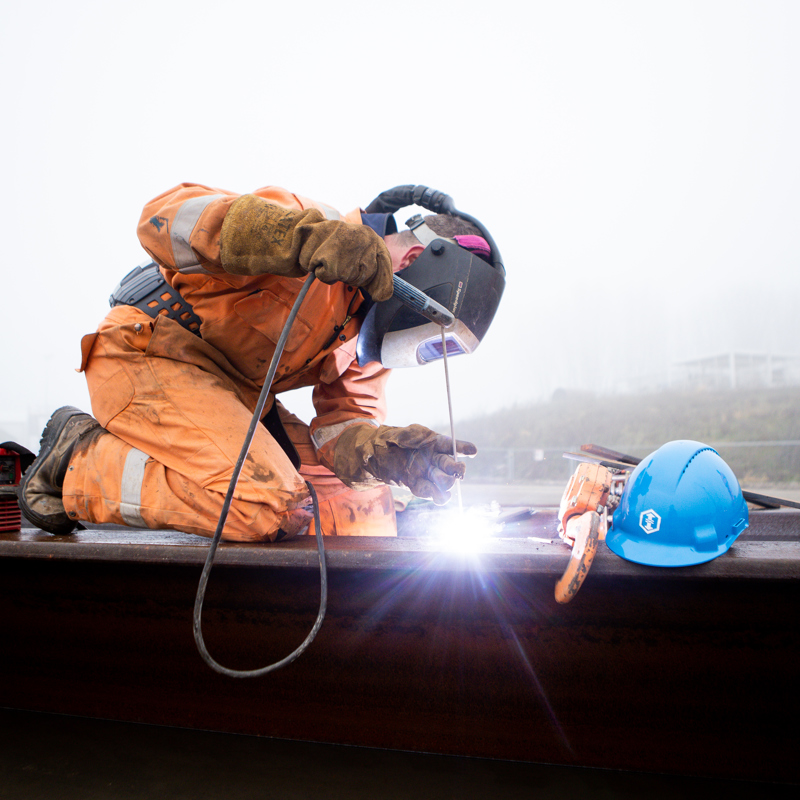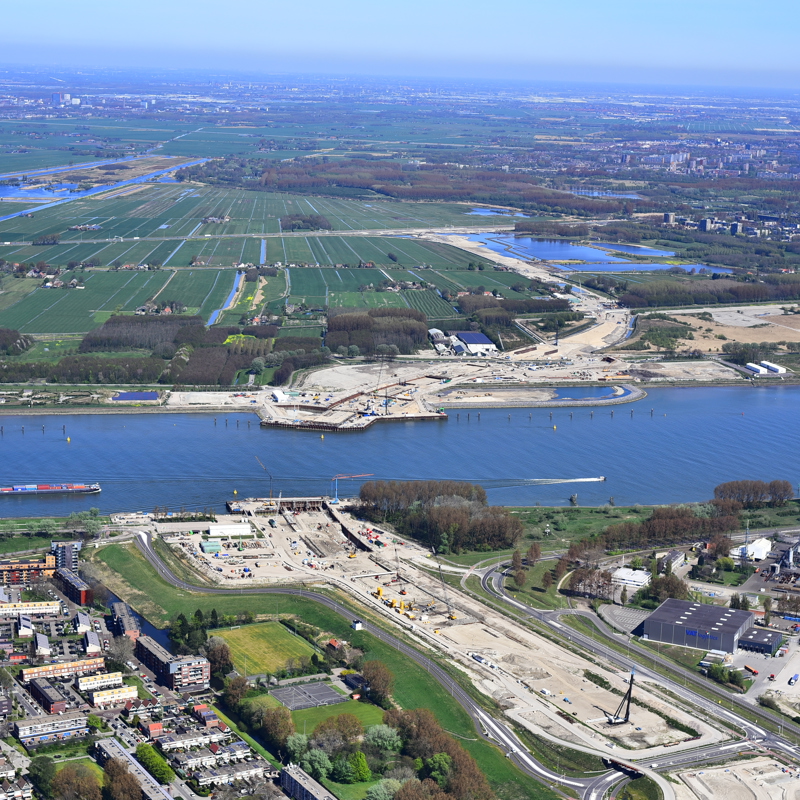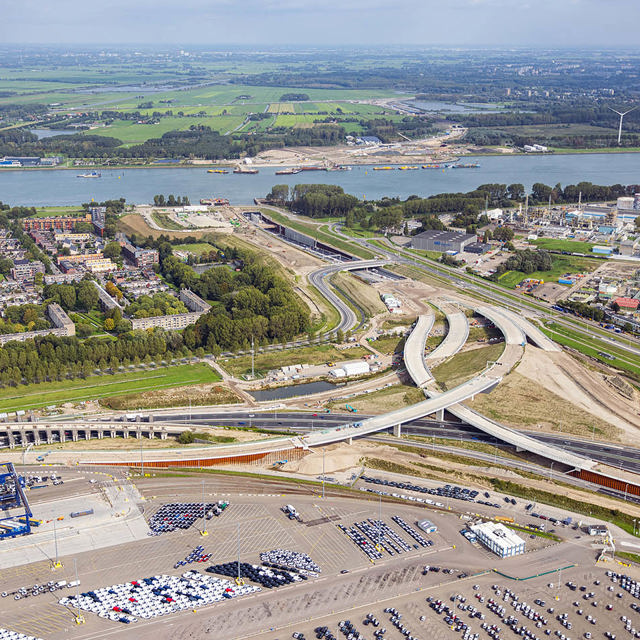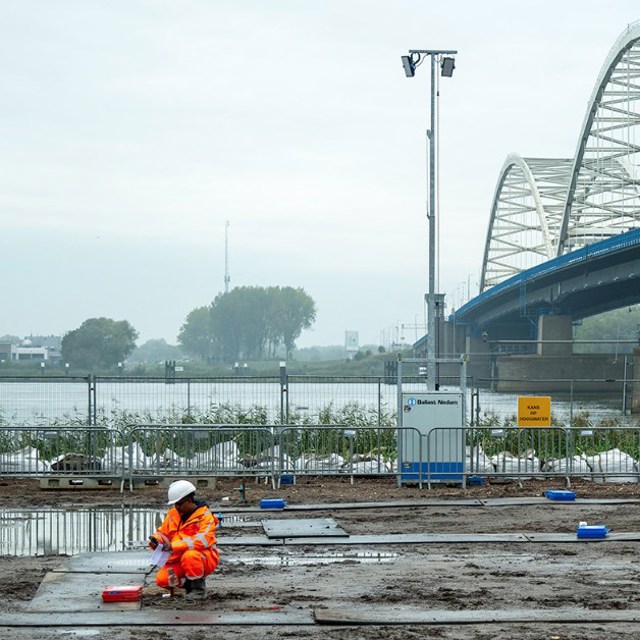Blankenburg link - new technical knowledge thanks to unknown phenomenon when sinking tunnel elements
The almost completed Blankenburg link covers 5 kilometres of new infrastructure, between the A20 near Vlaardingen and the A15 near Rozenburg. Technical highlight: a 945-metre-long immersed tunnel under the world’s busiest port route. For this Maasdeltatunnel, the two tunnel elements were immersed in 2023. The immersion operations appeared to be complex, where the final solution provided valuable new knowledge.
“The Nieuwe Waterweg is the busiest port route in the world. Road traffic has to cross that river properly. That was already possible via the Van Brienenoord Bridge, the Maasdeltatunnel and the first and second Benelux tunnels. What was still lacking was a connection that allows traffic to flow better between the north and the Maasvlaktes. This was discussed for decades, until it was finally decided to build the Blankenburg link in 2011. The stretch is expected to be completed in 2024. Cars and freight traffic will then have no, or at least less, congestion. This serves a great regional interest in an area where that huge port is still growing. But it also constitutes a good future investment for the region, given the importance of this area for the national economy.”
Critical stakeholders
That investment is not insignificant. It amounts to about € 1.2 billion. “In the world of civil construction, that is a huge amount”, Martijn says. “Together with our consortium partners DEME and Macquarie Capital, we are realising the whole thing as a DBFM project. So the contract includes the design, construction, 20 years of maintenance plus all the financing. On top of that, it represents a huge intervention in the environment. We have to deal with that carefully. The issues involved are diverse, from rehousing bats to rerouting the Botlek pipelines. There are quite a few stakeholders involved. Managing them also requires considerable effort.”
Patrick van Os knows all about that. He has been involved in this mega project on behalf of Ballast Nedam since 2016; first as tender manager and since 2017 as deputy project director. “On the north side, the project will take us under the river. That forms a natural division in the landscape, with two different municipalities on either side, and also two different water boards. Then we have many other stakeholders, such as the Port of Rotterdam. All these parties are working together, and are also critical stakeholders. Yet, they do not all have the same interests. For example, the usefulness of the project for the Port of Rotterdam is completely clear, but for the municipality of Vlaardingen, on the northern side of the route, this is to a lesser extent. They faced a plan for a motorway through a beautiful natural landscape full of picturesque farms and recreational facilities. That generated quite a bit of resistance. That was turned around slowly and it was decided to build the section there partly as a low-level highway and with a land tunnel. So you will hear, see and smell nothing at all of the new connection.”


Complex interaction of forces
Seen from Vlaardingen, the new A24 road passes four new structures: a low-level highway junction at the A20 motorway overflowing into the Holland Tunnel, the Maasdelta immersed tunnel and an elevated junction with the A15 at Rozenburg. The Maasdelta immersed tunnel is considered the project's masterpiece by those involved and also the media. Martijn understands that. “Especially the immersion operations of two tunnel elements, each about 200 metres long, under such a busy route, at the transition point between fresh and salt water, can definitely be called technical complex.” This proved to be the case in practice when the tunnel elements were immersed one by one in 2023. The first one involved an unexpected water leakage in a temporary seal, causing vessel traffic in the shipping channel to be blocked for longer than intended.
But it was while immersing the second element that an unexpected and serious problem presented itself. “Exactly where the tunnel is located is the transition between salt water coming from the North Sea by tidal movement and the fresh water of the river. We knew that, and we were also obviously familiar with the dynamics involved in the mixing of salt and fresh water. But here a strange interaction of forces occurred, which surprised us all.” What happened was the following: prior to the immersion, the tunnel element is still floating in the water. In doing so, 95% was under water and 5% above it. According to Archimedes law, the water formed the well-known buoyancy force, lifting the element. At the same time, the interaction of salt and fresh water caused so much additional current that an unforeseen interplay of forces arose. As a result, one of the winch cables holding the element in place snapped. The immersion operation was, for that moment, immediately aborted.
Updated technology
Every disadvantage has its advantage, as this event gave the team the opportunity to look for a solution to a previously unknown phenomenon. “We completely reconstructed the event afterwards, and found out what had happened. The team then adjusted the whole system of immersion and recalculated everything based on the new, increased forces. Among other things, this led us to work with heavier winches and thicker cables on the second immersion operation.” This operation had to be briefly postponed due to storm Babet, from October 21st to November 6th. But when immersion began on that day, the operation otherwise went smoothly. “I am proud that we managed to pull this off with the team. The cooperation went very well, as has been the case throughout the project. Not only with the consortium partners, but also with our client Rijkswaterstaat. Everyone made an effort all the time to look beyond their own boundaries and interests to achieve the common goal.”
What new knowledge has this project yielded, and in particular the course of events surrounding the immersion of the second tunnel element? “In short: that this salt-fresh water phenomenon exists, and how to solve it. With that in the background, we have made huge strides in terms of updated technology and digitalisation. In the world of tunnel immersion, it is standard practice to share such knowledge. To this end, I myself started an annual knowledge exchange meeting around 15 years ago. These are very well attended still by all the experts. By telling each other about our experiences, we advance our common field.” Martijn is not afraid of Ballast Nedam losing a competitive advantage as a result. ‘If I have learned one thing in my years of experience with immersed tunnels, it is that you can never copy anything from a previous project. This is because the conditions are literally different every time. Every tunnel immersion is unique, with its own conditions. In addition, it is our collective duty to take the profession forward and update our developed technology by sharing knowledge.”
Military operation
Martijn should know. He is considered an international tunnel immersion expert. In 1993, the Wijker tunnel formed his first immersed tunnel project, and since then he has been involved in 14 immersion tunnels among others in The Netherlands, Iraq, Czech Republic, Ireland, Denmark and South Korea. “Once you work on these projects, you get completely addicted. It is hyper technical and the complexity is huge, mainly through the dynamical systems involved. Failure is not an option, has always been my motto. So you approach it like a military operation. You go all the way with the team, which in turn brings a very nice sense of fraternisation. Working on immersed tunnels is simply the greatest thing there is.” After years in the middle of immersion practice, Martijn now has a different role as executive director. “I now actually watch more from a distance to see whether everything is going well, whether there are any steps backwards. But I also support the team in solving complex issues and when necessary still make engineering calculations for the team. That immediately makes my heart beat faster again.”
The edge of technical feasibility
Meanwhile, developments in the world of immersed tunnels are not standing still. Between Germany and Denmark, work is under way on the longest one in the world; the 18-kilometre-long Fehmarnbelt link. Ballast Nedam will start work in Basra, Iraq. There, the 2.5-kilometre-long immersed Silk Tunnel will form a link under the Khor Al Zubair canal. But first let's finish the Blankenburg link. Patrick definitely has a good feeling about it. “It really is a big and challenging project. Technically, of course, with the immersion of the Maasdelta tunnel, but also with the extremely deep excavation pits that were required. Normally these are at a maximum of 15 metres, but now it was 28 metres. After all, we had to go under the shipping channel, and then you end up at a considerable depth on the banks. There we really worked against the edge of what was technically feasible.”
A very different kind of challenge played out on the organisational front. “The project has widespread construction sites, with the interchanges, tunnels and both sides of the river. Therefore, it was necessary to work in sub-projects. These were physically separated from each other, so then it requires something to keep all heads going in the same direction all the time. We managed to do that partly thanks to a good communication and cooperation structure, in which we also literally sat around the table with each other periodically.” Patrick is proud of the fact that the core of the project team has remained intact all this time. “You sometimes experience that differently. I think it says something about the good functioning of the project team. I am really proud of that. But now the end of the project is in sight. It's all about the final construction work, finishing the tunnel, installing and testing the traffic systems, and then the cars can go through. And we are already setting our sights on the next immersed tunnel, in Iraq.”






